
|   |

|   |
 e-mail: leelakaverivenkat@gmail.com A delightful week of Kabir, Bharatanatyam and Swarna Saroja June 15, 2024 POETIC BLEND OF MYSTICISM OF KABIR AND KATHAK ABSTRACTION Choreographed by Ridhima Bagga, Utsav 2024 presented by students of Gauri Diwakar Sanskriti Foundation at the Shri Ram Centre, Delhi was a poetic delight. Sant Kabir's Dohas, Ramainis, Kaharvas and Shabads with their mystic underpinnings, make excellent material for Kathak dance given the dance's penchant for abstraction. And an artist with a combined Kathak/theatre background like Ridhima, is the right person to exploit this potential, while weaving a dance narrative. One must also admire Gauri Diwakar's total non-interference, leaving the field of dance visualization for students of her institution, completely to Bagga. 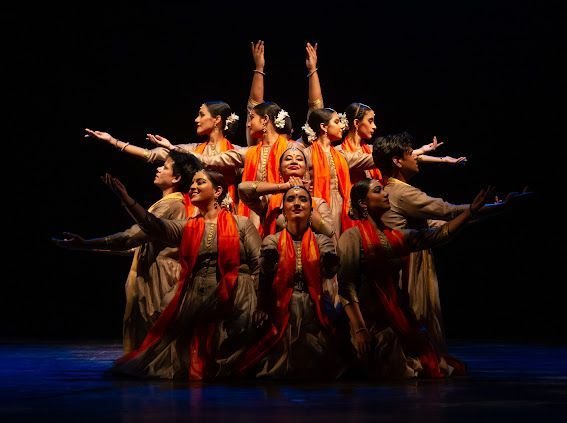 Gauri Diwakar's ensemble (Photo: Sanjit Debroy) Introducing youngsters of all ages to the Monotheism of Kabir is an excellent way of opening minds to ideas emphasizing love, spirituality and oneness of all religions with no dogmas, through teachings of one for whom Ram, Rahim and Allah were one and the same. Kabir's philosophy influenced Surdas, Tulsidas and above all Guru Nanak. Simple in language, but profound in philosophy gravitating towards transcendence and metaphysics, each person can absorb from this poetry according to his own level of understanding. Kabir's use of metaphor is underlined in lines like Chadariya jini re jini where body is compared to a delicate transparent sheet. The spinning wheel with eight lotuses which make it move, weaves in colours and qualities flowing from the five elements, into the sheet woven over a period of nine months. Aisa ranga raga rangarez ne, lalohi lalkar di. The reference is to the body which is shaped and grows over nine months before birth. But forgetting the temporary nature of life, people make this sheet (body) dirtier and dirtier. The working Charkha deals with the body and atma. The body gets coloured according to karma while atma is Brahmasthana. The ultimate weaver is God, who for Kabir is an experience of realization and not an entity with form. 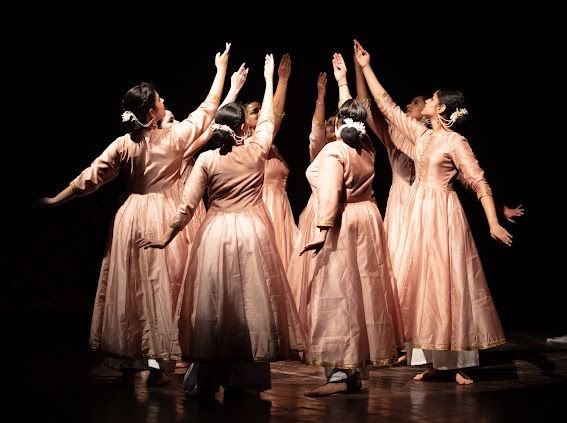 Gauri Diwakar's ensemble (Photo: Sanjit Debroy) What was so enchanting in the performance was the way various tala cycles, Kathak adforms, and the mystic poetry came together. With excellent group discipline, it was a delight to watch the tiny tots participating with the group. I particularly liked the way the poetry when it slipped into just pure dance, seemed to be an extension carrying the sonic quality of the words. The scene of 'Charka dhole' in a khandajati rhythm or scenes of play, dance, games, came together seamlessly. As man keeps running towards a supposed goal, milan or union seems to move away evading him. But he must go on with Hosh, Vivek, Jagrat. Finally comes the inner voice of realization. "You are running after something outside of yourself while I am within you. Look within and you will realize me," says the poet (Moko kahan doonde bande, Moko tere paas mey). Gauri Diwakar making a brief solo last minute entry with musical rhythm tak tak tak takita dhigita footwork made a fitting finale. Osho Rajneesh's text references from the book 'Kahe Kabir Main Poora Paaya' were also used. And for once this critic felt that the music did its bit to contribute to the total success. Music composition by Sudheer Rikhari with Samiullah Khan and Sudheer Rikhari himself on the vocals, Uma Shankar's sitar and Yogesh Gangani and Ashish Gangani on tabla and pakhawaj respectively, provided the kind of support for Kabira. It was so apt to take the "Jheeni jheeni" Gundecha Bandhu composition. Beauty of word, music, abstract rhythm moved in a symphony in this choreography. ENCHANTING BHARATANATYAM BY RAMYA SURESH 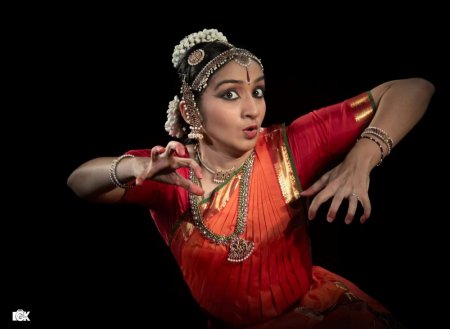 Ramya Suresh (Photo: Gaurav Kataria) It was IIC's Double Bill Concert, giving Delhi audiences a first exposure to Bharatanatyam by Ramya Suresh. The dancer epitomized, aside from the considerable talent, the advantages of a home background, wherein music and dance are a way of life. Husband Vishnu Ramprasad who has patented the instrument Navtar, is the son of established Carnatic vocalist T.V.Ramprasad and Indira Kadambi, Bharatanatyam dancer /teacher, specializing in abhinaya, for which she was trained for years under late Kalanidhi Narayanan, apart from being a nattuvangam specialist trained under Kamala Rani of Kalakshetra. Ramya Suresh herself, who initially trained under Guru B.Bhanumati and Sheela Chandrasekhar, before coming under the baton of Indira Kadambi, aside from her Bharatanatyam training, is a qualified doctor by profession as a pathologist. A challenging combination of careers indeed! Tastefully turned out, the dancer's recital began with a short slokam prologue, dedicated to Mannargudi Rajagopalan in raga Desh, followed by a varnam "Sarasijakshulu" in ragam Kalyani, a composition of Shivanandam Pillai. The opening jati itself, in the placement of sollus, evoked a sparkling electric quality, with the first sahitya line expatiating on the lovelorn Nayika's deep longing for the lotus eyed Jagadrakshaka. The usual dance metaphors depicting sringar showing the billing and cooing birds, with the entire flora and fauna too drawn to the mesmerizing flute sounds, in sheer adoration for Sundara Raja Gopala, with the charanam line complaining about Manmatha's love darts adding to the heroine's pangs, were all on oft expressed lines. But what made each light footed jump and immaculate footwork in the teermanams special, not forgetting the punch filled arudis, topped by the dancer's wonderfully expressive abhinaya and gestures, flowed from the dancer's artistry - flowering in perfect synchronization with the wonderful accompaniments she had with acharya Indira Kadambi wielding the cymbals providing the nattuvangam lead, with melodious vocal support of Rohit Bal, punctuated by the instrumental raga embellishment provided by Vishnu Ramprasad on the Navtar with Delhi's Manohar Balatchandirane providing mridangam support. 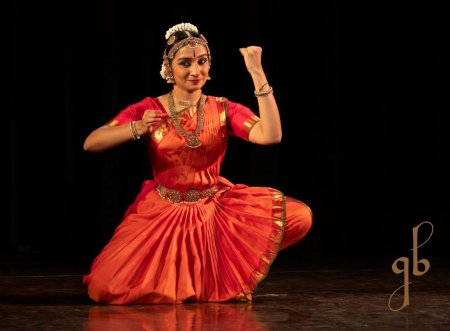 Ramya Suresh (Photo: Govindswamy Balatchandirane) After the sringar laden centerpiece, the post varnam abhinaya provided the right counterpoint in mood, with hasya rasa, which rarely gets prolific treatment in Bharatanatyam performances. Purandara Dasa's "Boochi bandide" saw mother Yashoda struggling with a recalcitrant child Krishna fighting sleep. Her lullaby comes in the form of narrating about the three eyed monster which lurks on the terrace and on top of trees, peeping in to quietly smuggle away children who refuse to go to bed. Whether child Krishna is convinced or not, sleep finally overcomes the young one's restless energy. What one found challenging was in preserving the sthayi of humour with the figure of the mother as the protagonist not being made to look like a ludicrous figure, even while making faces, trying to scare the child to sleep. Very convincingly portrayed! The Lalgudi Jayaraman tillana rang in the right finishing touch to what was a delightful concert. GANESA NATYALAYA'S HOMAGE TO SWARNA SAROJA As Ganesa Natyalaya, the largest institution for Bharatanatyam in the capital, observes its diamond Jubilee of just over fifty years of serving dance, amidst the poignant absence of its founder Saroja Vaidyanathan, presiding over the destiny of the institution for years. In a seamless natural handover of reins to the family members, the work of the institution has not suffered. With Saroja's son Kamesh taking over the administrative functioning, and her teaching baton handed over to daughter-in-law Rama Vaidyanathan, with granddaughter Dakshina Baghel also working as an active teacher conducting regular classes, it is largely the absence of the much loved persona of Saroja that students miss. Swarna Saroja programmes conceived as homage to the founder to be held throughout the year, very understandably held its event at the Ganesa Natyalaya premises on June 2. Given its spacious central hall accommodating a fully equipped stage with all the paraphernalia for performing, and with Saroja memorabilia everywhere evoking a special aura, it is the wisest move to hold the event in the place where she reigned for so many years. Spurred by memories of past collaborative efforts with Saroja, were many senior dancers in the packed hall. So different from the cold auditoria where even established dancers have been performing to pitifully thin audiences in Delhi! The evening began with the uncovering of a Mandala painting by a student of the Natyalaya, Anoushka Jindal, representing Swarna Saraswati, the golden, bright, many splendoured Goddess excelling in so many art disciplines - here a representation of Swarna Saroja with her multiple accomplishments. 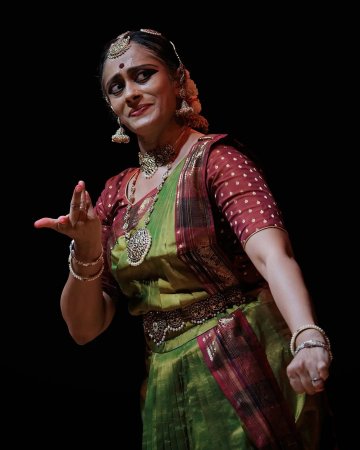 Anuradha Venkataraman The first artiste of the evening was one of Saroja's senior most disciples Anuradha Venkataraman, whose performances one has memories of having attended almost two and half decades ago. Looking for all purposes the same as one remembers her, Anuradha, now settled in Bangalore, would seem to be dancing better than ever. The Todi varnam she presented "Dani Sama Rajendra Gamini Tapam iha Kamini" showed the Nayika weighed down by her unrequited love for Padmanabha. Addressing the elephant gaited sakhi, the graceful albeit ponderous steps of a body is weighed down by the pent up pangs of unfulfilled love. Neat in technique and dance lines, Anuradha's presentation of the teermanams was characterized by impeccable laya precision, with the composer of the jatis Lalgudi Ganesh, himself wielding percussive support on the mridangam. One could sense the loss of the guru, felt by the dancer, when she spoke a few words at the end. The second half of the programme was by senior Kathak dancer Uma Dogra, a disciple of late Guru Durga Lal. Ironically, for a person studying under such a master of laya, never associated by onlookers with any kind of abhinaya barring the bhakti of belief, Uma's performance largely based on abhinaya, came as a surprise. The dancer is the first to admit that her connection with the mimetic side of the dance, in its deep involvement, began only after her Guru's passing away. Her connection with music, with a father musician, helped in the musicality of compositions for abhinaya, with her own individualistic inputs. Uma began her recital with Shiv Vandana showing through postures the Lord as Sashishekharaya, Vishweshvaraya, Jatadharaya et al, after which, she ended with footwork dha dha dhinta, kitadha dhinta. 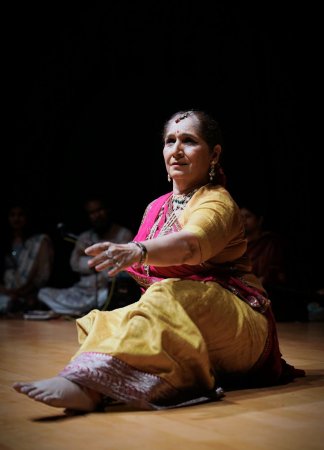 Uma Dogra The mimetic part began with a Meera composition "Baso mere naninaname Nandlal" set to raga Bageshri. While Meera's compositions on Krishna spoke of her deep seated sringar for the Lord, Uma has used the composition from the vatsalya perspective, for the words do not make a direct reference to a man/woman relationship. Depicting mother Yashoda's love for her foster child as she lovingly plays, bathes, massages and fondles baby Krishna, made to lie on her two outstretched legs, a plus point, along with her involved rendition was the vocal support of Manoj Desai. The next abhinaya composition concerned sringar in the romantic vein, based on a Thumri in Misra Khamach - Dagar vich kaise chaloon mat chado Kanhaiya - to which Uma has tagged on a few lines of Dharam Veer Bharati's Kannupriya, considered by many to reflect the essence of a woman's responses in sringar relationships. The last item, again in the expressional mode was what is considered the acme of sringar compositions, namely, a Jayadeva ashtapadi for which the musical score (referred to by Uma as a melody, more expressive of mood) composed by Vinayak Netke was set in the Dadra mode, which in Hindustani music, is often preferred while accommodating sahitya in languages other than Hindi. The inspiration for this item came from late Guru Kelucharan Mohapatra, who was referred to as the manasik Guru by Uma - for she was of the opinion that there are few who can better this Guru's inner response to word, music, and mood in dance. Be that as it may "Keshi mathanam udaram" is one of the most passionate ashtapadis with Radha, full of desire, demanding of the sakhi to fetch 'that killer (tormentor) of Keshi' to her side immediately, the metaphor clearly expressing Radha's frenzy of desire. The ashtapadi contains a recount of her first moments of intimacy with Krishna and how he overcame her shyness, as she falls over a bed of ferns ("kishalaya shayana niveshitaya...") which, in Uma's response saw her stretched on the floor. Despite her uninhibited rendition, one has to admit that for a mind so conditioned to the vibes of Bhubaneswar Misra's musical composition of this ashtapadi for Odissi dancers, the music sounded somewhat alien. Uma also spoke fondly of collaborations with Saroja Vaidyanathan which had been a learning experience for her.  Writing on the dance scene for the last forty years, Leela Venkataraman's incisive comments on performances of all dance forms, participation in dance discussions both in India and abroad, and as a regular contributor to Hindu Friday Review, journals like Sruti and Nartanam, makes her voice respected for its balanced critiquing. She is the author of several books like Indian Classical dance: Tradition in Transition, Classical Dance in India and Indian Classical dance: The Renaissance and Beyond. Post your comments Pl provide your name and email id along with your comment. All appropriate comments posted with name and email id in the blog will also be featured in the site. |